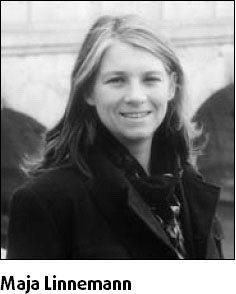| Home / Living in China / Expat Tales | Tools: Save | Print | E-mail | Most Read |
| German Helps Beijing Maintain Its Style |
| Adjust font size: |
For Maja Linnemann, a native of "When you go into a hutong, it is so quiet. It is like a small oasis, a little paradise to me," she said.
Unlike many of the tourists walking through the capital's famed courtyard homes, Linnemann is on a serious mission checking to make sure Beijing's siheyuan, (traditional residential compounds native to North China), are being adequately protected from demolition. Linnemann participated in a nine-month project called "Friends of Old Beijing" that was organized by the The NGO asked volunteers to go for regular walks among the hutongs to help monitor conditions in old parts of the city. Linnemann and three other volunteers, one from Experts taught the volunteers about old "If you only go to a hutong once or twice, you will find it very nice and romantic. But if you go often into the siheyuan, it is very crowded. Sometimes you can see like 20 or 25 electricity meters (reflecting the large number of people living inside), and that is very astonishing," Linnemann said. Many siheyuan do not even have a courtyard because of new construction inside. It can be difficult to find an original structure. "Sometimes when we see half of a chuihuamen (decorated gate) covered in concrete, because something is being built, it makes us feel so sad. It is like looking at an old man, who had a rich life, but now is sick and nobody cares for him." In general, the hutong in the area to which her group was assigned are in good condition, she said. In addition to her fondness for the actual hutongs, Linnemann said she was drawn to the project by the possibility that she might get to talk to the residents and understand their lives. "When we walked in the cold winter mornings, people would ask us to come into the house and have some tea. It is not so easy to get to talk to people in Through those conversations, she said she was able to understand Beijingers' take on life. "There is not very much appreciation among the local people (for protection work)," she said. "People want to leave the old houses and prefer better living. I understand this." In "When your neighbor is coughing and quarrelling, you have to hear it. You have no privacy. You don't have your own bathroom. It is a very low standard of living there," she said. "Hutong are so typical of Eventually, her group will write a report for the reference of the local cultural heritage bureau. They will also choose 10 of the most interesting buildings and design a heritage trail for tourists. ( |
| Tools: Save | Print | E-mail | Most Read |
 |
| Related Stories |
|
